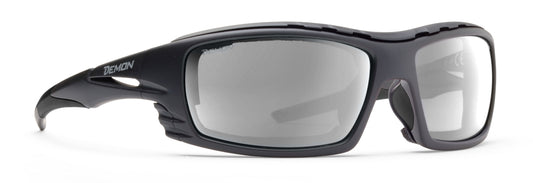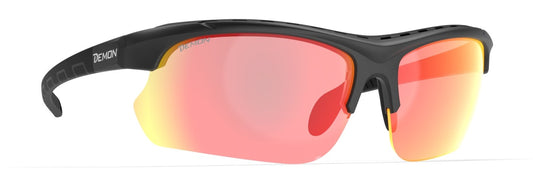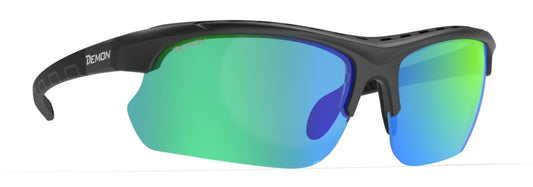-
INFINITE OPTIC 2
Vendor:Sports Glasses with Polarized Mirror LensesRegular price €99,90Regular priceUnit price / per -
INFINITE OPTIC 2
Vendor:Sports Glasses with Mirrored LensesRegular price €69,90Regular priceUnit price / per -
INFINITE OPTIC
Vendor:Mountain Glasses with Photochromic Lens DCHROM® Cat1-3Regular price €99,90Regular priceUnit price / per
Collection: Hiking Sunglasses
HIKING SUNGLASSES
Hiking is an outdoor sporting activity centered around walking in mountainous areas for study or leisure purposes, typically along rugged routes that are inaccessible by conventional means of transportation. Paths, long-distance trails, high routes, mule tracks, and bridle paths are just a few examples of routes suitable for hiking.
In English, hiking is also referred to as trekking, with the former term derived from the English verb "to trek," meaning to walk slowly or embark on a long journey, and the latter from the verb "to hike," which simply means to walk.

Generally, hiking occurs in mountain or natural environments and may include activities such as birdwatching, observing botanical species, or visiting monuments and natural landmarks along the route.
A particularly long excursion that traverses a mountain range or group of mountains is referred to as a crossing.
Responsible hikers should demonstrate respect for the environment they traverse by avoiding excessive noise, staying on designated paths, refraining from altering signs, and properly disposing of waste by either compacting it and carrying it to designated bins or, preferably, to urban areas at the base of the valley.
It's important not to disturb protected botanical species or harass wildlife, to light fires only in appropriate areas with sufficient expertise, to fully extinguish them before leaving, and to refrain from discarding cigarette butts or paper tissues. It’s customary among hikers to greet one another when passing on a trail and, whenever possible, to assist fellow hikers in need.

PREPARATION
To prevent potentially serious issues, such as getting lost or being caught in a sudden storm, it is important to plan several factors in advance:
- The route: including the topographic profile, overall elevation gain, terrain characteristics, and landmarks for orientation.
- The estimated duration: planned stages, and locations of refuges or shelters along the way.
- Anticipated weather conditions: including forecasts for the duration of the hike.
- Proper clothing: particularly suitable footwear for the terrain and weather conditions.
- Necessary equipment: including essential accessories, backpacks, tents, cooking stoves, utensils, etc.
- Sufficient water and food supplies: for the duration of the hike.
APPAREL
Clothing naturally varies according to the seasons, but it's essential to consider potential changes in weather conditions.
It's advisable to always carry waterproof clothing to wear in case of an emergency. Additionally, opt for boots appropriate for the terrain you'll encounter and choose hiking socks, preferably seamless, with a specialized structure for enhanced comfort.

EQUIPMENT
When it comes to equipment, it should encompass all the essential items for orientation and useful accessories in case of difficulty. Particularly if you are not accompanied by qualified guides or experienced local hikers, it's advisable to bring along a range of useful accessories, even if not all of them are indispensable:
- A detailed topographic map of the area to be explored, preferably a military or CAI map (ideally at least on a 1:25,000 scale).
- A compass and, optionally (but not as an alternative), a GPS receiver.
- A multi-purpose knife (Swiss Army knife type).
- An isothermal blanket.
- A first aid kit.
- A supply of water (drink regularly to prevent loss of mineral salts) and energy sources (e.g., wholemeal and/or diet biscuits, canned food). While chocolate is popular among hikers, it is not ideal as it is mostly composed of fats, which are slow to assimilate. It’s better to use simple sugars like fructose (avoid sucrose, which causes glycemic spikes) or maltodextrins.
- Sunscreen (essential) with a UV protection factor suitable for altitude and duration of exposure.
- A whistle (useful for distress signals).
- A flashlight or headlamp (handy when darkness catches you).
- Gloves and a hat (for temperature drops, even in summer).
- A fully charged mobile phone (check signal coverage based on location), plus batteries and phone credit. Two walkie-talkies can also be useful for keeping the hiking group together (one at the front and one at the back).
- Clothing, preferably layered, suitable for the seasons and weather conditions.
- A helmet (particularly in high mountains and near rocky walls).
- Hiking poles or sticks, which help with propulsion using the upper limbs, aiding progress along the trail, reducing fatigue, and lowering the risk of slipping or falling.
- A 5-meter rope for hanging and other uses (lashing, splints, shoulder straps, etc.).
- Certified sunglasses (with at least UV protection 4 for excursions on snow or ice).
For multi-day excursions, depending on your requirements, it's advisable to consider adding:
- A sleeping bag (appropriate for the prevailing seasons, considering expected temperatures).
- A sleeping bag liner (often required in many refuges).
- A tarpaulin for shelter or a tent, along with a camping stove.
In addition to the essential equipment:
- In glacier sections, the use of crampons and an ice axe is mandatory, and in the presence of crevasses, it is advisable to proceed roped together.
- For via ferratas, it is obligatory to wear a harness, helmet, via ferrata set (including a heat sink, two carabiners, and a properly prepared rope), and sturdy boots along with gloves that allow the use of carabiners (similar to those used by cyclists).
- If crossing streams or navigating particularly exposed or hazardous areas is anticipated, it is recommended for the group to carry a length of rope at least twenty meters long.

























 English
English Deutsch
Deutsch Français
Français Español
Español Nederlands
Nederlands Português
Português Русский
Русский Polski
Polski Svenska
Svenska Norsk bokmål
Norsk bokmål Dansk
Dansk Suomi
Suomi Čeština
Čeština Magyar
Magyar Română
Română Slovenčina
Slovenčina Slovenščina
Slovenščina Hrvatski
Hrvatski Српски језик
Српски језик Български
Български Latviešu valoda
Latviešu valoda Lietuvių kalba
Lietuvių kalba Lëtzebuergesch
Lëtzebuergesch Türkçe
Türkçe 日本語
日本語 العربية
العربية 简体中文
简体中文 繁體中文
繁體中文 हिन्दी
हिन्दी ਪੰਜਾਬੀ
ਪੰਜਾਬੀ বাংলা
বাংলা